Path Spread
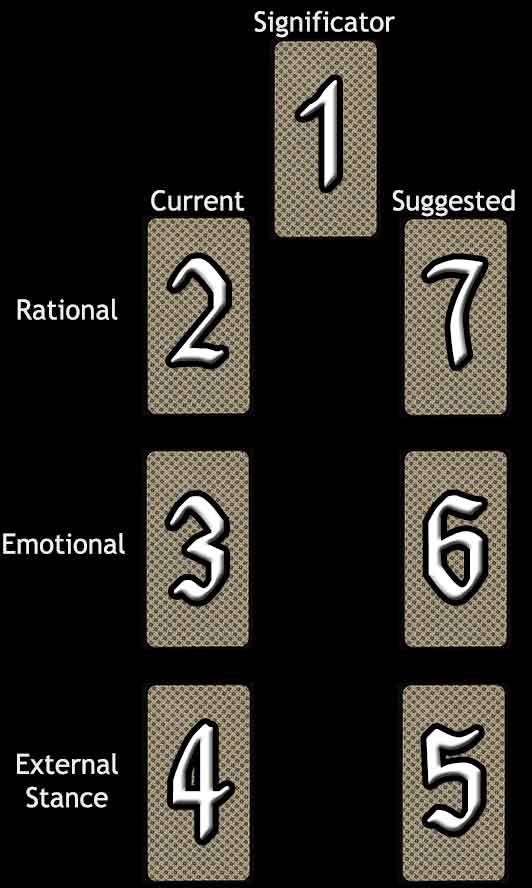
Difficulty: Easy
For the Path reading, one asks for suggestions how to behave properly to achieve a desired result. The Current column represents how the reader has been acting, and the Suggestedcolumn suggests how they should act to achieve a certain goal. The chart-like spread uses the standard three levels: Rational, Emotional, and External Stance (how one projects oneself outwardly). When comparing the Current and Suggested cards, the most important thing is to notice the differences between the two cards. It is these differences which hint at the behaviours that should be altered.
Card #1 is the significator, the card which should reflect the nature of the query and/or the desired outcome.
Card #2 shows the way the reader is and has been thinking. Card #7 suggests how to change the way one thinks to serve themselves better.
Card #3 suggests the reader's emotional attitude. Though it may seem difficult to manipulate one's own emotions, it can be done if one puts their mind to it. For example, acting a certain way such as smiling intently for a few minutes will lead the emotions to follow. When a person tries this, as silly as the exercise seems, they find this to evoke the emotion of happiness. For this reading, one should try to make themselves feel the way that Card #6 suggests.
External Stance means how one acts outwardly, how they hope others see them. Card #4 is about how the reader has been acting, while #5 indicates how they should act outwardly, for other people's sake. It is the differences between these cards that hint at what behaviour patterns should be altered.
Your Path Reading
Current |
The Significator 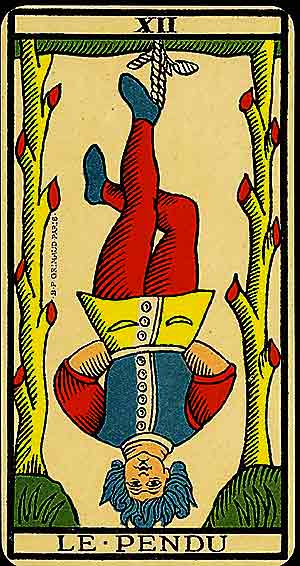 XII – The Hanged Man (Le Pendu) |
Suggested |
|
Thought |
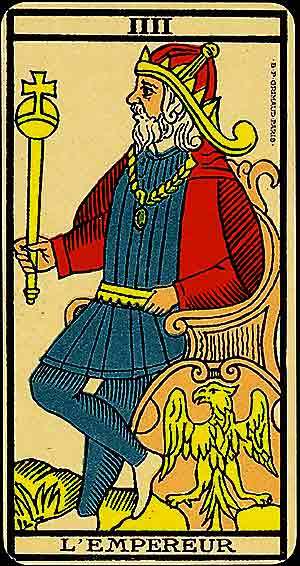 IIII – The Emperor (L'Empereur) |
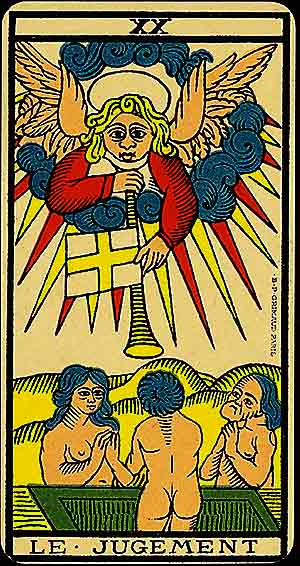 XX – Judgement (Le Jugement) |
|
Emotion |
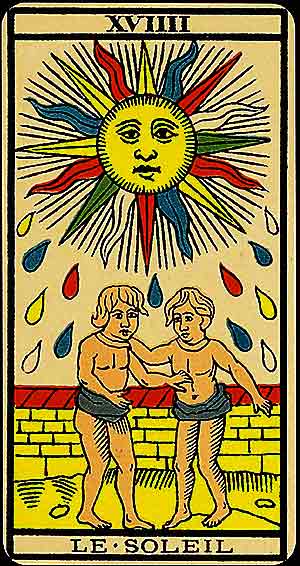 XVIIII – The Sun (Le Soleil) |
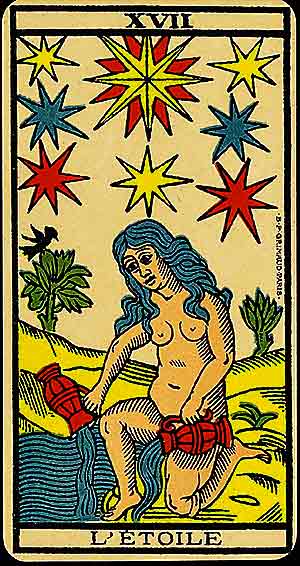 XVII – The Star (L'Étoile) |
|
External Stance |
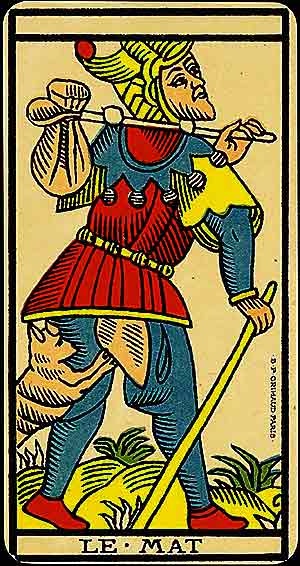 0 – The Fool (Le Mat) |
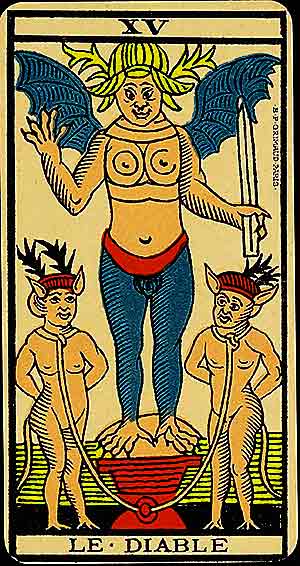 XV – The Devil (Le Diable) |

The Significator
XII – The Hanged Man (Le Pendu)
The Hanged Man represents surrender, perspective, and the wisdom gained through sacrifice. It signifies the pause required for deeper insight and the willingness to let go of attachments to achieve spiritual growth.
Symbolism: A figure hangs upside down from a grafted tree, forming an almost serene cross-like posture. The inversion suggests seeing the world from a different perspective, while the living tree structure reflects the connection to spiritual growth. His tranquil expression emphasises acceptance and enlightenment through suspension.
In Relationships: A need for patience, reflection, or a fresh perspective on a relationship. It can also suggest letting go of control.
In Work: A time to pause, reassess, and allow things to unfold. Solutions may come from viewing challenges differently.
Spiritually: The Hanged Man invites the seeker to embrace surrender as a path to awakening and profound understanding.
When ill-dignified: Stubbornness, resistance to change, or avoiding necessary sacrifices. It warns against remaining stuck in unproductive situations.

Current Thoughts
IIII – The Emperor (L'Empereur)
The Emperor embodies structure, authority, and the power of order. He is the architect of stability, encouraging discipline and leadership in the material world.
Symbolism: The Emperor's throne and square-shaped setting symbolise structure and the solid foundation of his rulership. The sceptre and orb he holds reflect his control over earthly domains. His gaze is firm and unyielding, emphasising responsibility and focus.
In Relationships: Stability, loyalty, and shared goals define relationships under the Emperor's influence. It may also indicate a partner with strong authoritative traits.
In Work: Success through organisation, discipline, and strategic planning. Leadership is both a gift and a responsibility.
Spiritually: The Emperor teaches the balance between setting boundaries and allowing the divine to flow within the constraints of the physical world.
When ill-dignified: Rigidity, stubbornness, or misuse of power. It warns against being controlling or dismissive of emotional needs.

Suggested Thoughts
XX – Judgement (Le Jugement)
Judgement signifies awakening, transformation, and the call to a higher purpose. It represents a time of reckoning and renewal, offering the opportunity to align with divine will and embrace rebirth.
Symbolism: An angel blows a trumpet from above, awakening figures rising from coffins below. The trumpet symbolises divine calling, while the figures' praying hands reflect surrender and readiness for transformation. The scene suggests liberation and the promise of a new phase of existence.
In Relationships: Healing, forgiveness, or a transformative phase. It may signify a second chance or a fresh start.
In Work: A moment of clarity or a major decision that aligns your work with your higher purpose. Renewal is on the horizon.
Spiritually: Judgement calls you to awaken to your true calling, embrace forgiveness, and prepare for a spiritual rebirth.
When ill-dignified: Resistance to change, self-doubt, or avoidance of accountability. It warns against ignoring the call to transform.

Current Emotions
XVIIII – The Sun (Le Soleil)
The Sun represents joy, success, and clarity. It is the card of illumination and vitality, promising growth, harmony, and the fulfilment of goals through clarity and connection.
Symbolism: Two children stand joyfully under the radiant Sun, surrounded by a protective wall. The Sun itself symbolises divine energy and enlightenment, while the figures reflect innocence, unity, and shared happiness. The vibrant rays evoke abundance and the thriving life force.
In Relationships: Mutual happiness, harmony, and a joyful connection. Relationships flourish under the light of clarity and love.
In Work: Success and recognition achieved through positivity and effort. It suggests a time of clarity and accomplishment.
Spiritually: The Sun calls for embracing the light within and aligning with your true purpose, radiating joy and love outward.
When ill-dignified: Arrogance, burnout, or overexposure. It warns against taking blessings for granted or letting ego overshadow gratitude.

Suggested Emotions
XVII – The Star (L'Étoile)
The Star is a card of hope, inspiration, and renewal. It symbolises divine guidance and the gentle flow of healing energy after hardship.
Symbolism: A nude figure kneels beside a stream, pouring water onto the land and back into the source, representing the cyclical nature of renewal and the flow of inspiration. Above her, stars shine brightly, offering hope and illumination.
In Relationships: Healing and harmony. It suggests vulnerability and openness to connection.
In Work: Inspiration and the emergence of new opportunities. A time for trust in your creative vision.
Spiritually: The Star invites you to align with your higher purpose, finding peace in the guidance of the cosmos.
When ill-dignified: Doubt, loss of faith, or feeling disconnected from inspiration. It warns against losing hope during challenging times.

Current External Stance
0 – The Fool (Le Mat)
The Fool represents the untamed spirit and unshackled freedom of the soul. He wanders without boundaries, embodying movement, exploration, and detachment from worldly concerns. This card invites us to embrace change and unpredictability with courage and spontaneity.
Symbolism: The dog biting at the Fool's leg symbolises the tension between freedom and earthly constraints. His staff and bundle represent the burdens and wisdom accumulated on life's journey, carried with both carelessness and purpose. The colourful jester's attire signifies his eccentricity and adaptability, while his forward gaze reflects an openness to the unknown.
In Relationships: A new, unpredictable connection or the need for more spontaneity in existing relationships. Beware of recklessness.
In Work: Embarking on a risky or unconventional path, where intuition takes precedence over plans.
Spiritually: The Fool embodies the soul's leap into the vast unknown, trusting the divine order of chaos.
When ill-dignified: Naivety, poor judgement, or a lack of grounding. It warns of becoming aimless or distracted by superficial pursuits.

Suggested External Stance
XV – The Devil (Le Diable)
The Devil represents temptation, materialism, and the power of the shadow self. While it warns of unhealthy attachments, it also offers an opportunity to confront and integrate the darker aspects of human nature.
Symbolism: A horned figure dominates the scene, with two smaller chained figures below, symbolising bondage to desires or fears. The loose chains suggest that this bondage is self-imposed and can be escaped. The card's imagery reflects both the allure and consequences of indulgence.
In Relationships: Obsessive or co-dependent relationships. It may indicate intense passion or unhealthy dynamics.
In Work: Temptation to take shortcuts or pursue goals at the expense of ethics. A need to reassess priorities.
Spiritually: The Devil challenges you to confront your shadow self and transform fears into liberation.
When ill-dignified: Escapism, addiction, or manipulative behaviours. It warns of being trapped in destructive patterns.